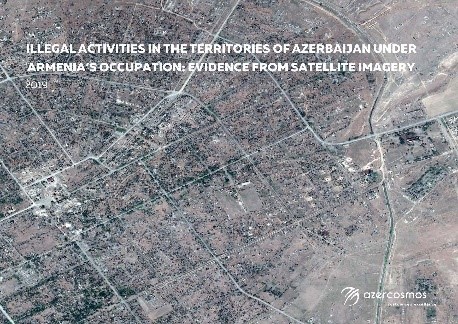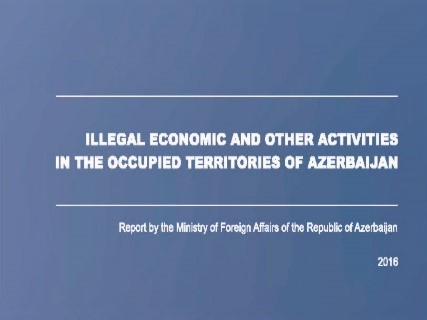The Government of the Republic of Azerbaijan has regularly informed international community, including the UN and OSCE about Armenia’s actions aimed at consolidation of the status quo of the occupation and securing the annexation of territories of Azerbaijan that it captured through military force. In this regard, particular attention has been given to the issue of illegal settlements in the occupied territories of Azerbaijan native population of which were completely expelled by Armenia.
Armenia has transferred settlers to the occupied territories of Azerbaijan not only from Armenia, but also from other countries, including from the Middle Eastern countries which host sizeable Armenian diaspora and suffer from internal instability (such as Syria or Iraq). For example, many Armenians from Syria, particularly from Syrian towns of Qamishli and Aleppo, have been transferred to the occupied territories of Azerbaijan. There were reports that refugees from Syria and Iraq implanted in the occupied territories were being recruited to serve in the armed forces of Armenia deployed in the occupied territories.
Settlement activities in the occupied territories were carried out in a pre-planned and organized manner with clearly defined objective and geographic focus.
Armenia made a particular focus on settling the occupied districts which had no Armenian population before the occupation (for instance, Lachyn, Kalbajar, Gubadly and etc). To that end, permanent social and economic infrastructure in support of settlement enterprise were constructed.
These illegal activities were pursued against the background of announcements by the successive officials of Armenia that Armenia would not return or even not holding negotiations to return any territory to Azerbaijan.
Implantation of settlers run in parallel to changing the Azerbaijani ethno-cultural features of these territories. Almost all native toponyms of historical Azerbaijani places in the occupied territories were altered. For example Shusha, Lachyn and Kalbajar were referred to by Armenia as “Shushi”, “Berdzor” and “Karvachar” respectively. In the context of changing of original toponyms, it should be also mentioned that Armenia was resorting to such incentive tricks, like granting to the new and existing settlements the geographic names with clear historical connotation (like “New Cilicia”, “Van” etc.) in an effort to draw historical parallels, exploit sentiments and thus encourage more Armenians to move to the occupied territories.
A scheme of subsidies and incentives were put in place to encourage Armenian settlers to move to the occupied territories. Various methods employed at different stages of the settlement process included the provision of subsidies, mainly related to discounted or free utilities, free construction materials, low or no taxes, free provision of material support (a house/apartment, land and other assistance), the provision of agricultural grants, credits and cattle etc. Special social programmes (mainly in the form of one-time financial assistance for the first, second and more children and the provision with a house for families with six children under the age of 18), were designed to stimulate natural growth among the settlers and indicate the existence of policy driven repopulation efforts.
Armenia conducted its illegal activities not only through its State organs, but also its Diaspora and charity organizations. For instance, Armenia-founded and controlled Hayastan All-Armenian Fund designed and implemented a special “Re-population of the villages of Artsakh” project.
By its illegal settlement policy in the occupied territories of Azerbaijan Armenia violated the resolutions adopted by the United Nations Security Council (822 (1993), 853 (1993), 874 (1993), 884 (1993)) and General Assembly (A/Res/48/114 and A/Res/62/243) and international humanitarian law. Thus, article 49 of the Fourth Geneva Convention, to which Armenia is a party, provides that “the Occupying Power shall not deport or transfer parts of its own civilian population into the territory it occupies”. This constitutes the basis and expression of a rule of law prohibiting the establishment of settlements in the occupied territories consisting of the population of the occupying Power or of persons encouraged by the occupying Power with the intention, expressed or otherwise, of changing the demographic balance.
In addition to the traditional rules of humanitarian law, in regard to the occupied territories, Armenia is also bound by the provisions of those international human rights treaties, including the International Covenant on Civil and Political Rights, the International Covenant on Economic, Social and Cultural Rights, the International Convention on the Elimination of All Forms of Racial Discrimination and the European Convention on Human Rights. To the extent that Armenia has violated the relevant applicable law with regard to the occupation of the territory of Azerbaijan, it is responsible under international law.
Changing historical and cultural nature of the occupied territories, erasing everything which associates these territories with Azerbaijan and Azerbaijanis, artificially increasing the Armenian population therein and many other illegal deeds were undertaken by Armenia with the sole purpose to annex the occupied territories of Azerbaijan. This policy was in complete contradiction to the negotiations on the settlement of the conflict, the framework of which had been identified by the related UN SC resolutions and OSCE documents. It has been illustrative of Armenia’s stance towards the negotiations and revealed the true reason why they have not yielded any result.
More details on the illegal settlements in the territories of Azerbaijan subjected to occupation by Armenia can be found in the following reports
|
ILLEGAL ACTIVITIES IN THE TERRITORIES OF |
|
ILLEGAL ACTIVITIES IN THE TERRITORIES OF AZERBAIJAN UNDER ARMENIA'S OCCUPATION: EVIDENCE FROM SATELLITE IMAGERY Report by the Ministry of Foreign Affairs of the Republic of Azerbaijan (2016)
|


